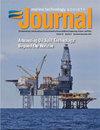基于深度学习的水声矢量传感器阵列数据驱动DOA估计方法
IF 1
4区 工程技术
Q4 ENGINEERING, OCEAN
引用次数: 0
摘要
到达方向估计是水声矢量传感器阵列信号处理中的一个基本问题。由于深度学习技术的优势,本文提出了两类数据驱动的水声矢量传感器阵列DOA估计方法,将DOA估计问题转化为神经网络分类问题。具体来说,一种是基于师生降噪的卷积神经网络DOA估计方法(TS-CNN),该方法将协方差矩阵作为训练数据集;另一种是采用时域信号作为训练数据集的基于长短期记忆网络和注意机制的DOA估计方法(LSTM-ATT)。实验仿真结果表明:1)当阵列元数较少时,基于TS-CNN的DOA估计方法精度与传统方法相当,且在信噪比较低时能有效抑制噪声的影响;2)基于LSTM-ATT的DOA估计方法的精度远远高于传统的多信号分类方法,特别是在低信噪比的情况下,这也证明了在真实环境中时间特征对DOA估计的重要性。本文章由计算机程序翻译,如有差异,请以英文原文为准。
Data-Driven DOA Estimation Methods Based on Deep Learning for Underwater Acoustic Vector Sensor Array
Abstract Direction of arrival (DOA) estimation is a fundamental problem in underwater acoustic vector sensor array signal processing. Because of the advantages of deep learning technology, this paper proposes two categories of data-driven DOA estimation methods for underwater acoustic vector sensor array, which transform the DOA estimation problem into a neural network classification problem. Specifically, one is the DOA estimation method of convolutional neural network based on teacher-student noise reduction (TS-CNN), which considers the covariance matrix as the training data set; the other is a DOA estimation method based on long-short term memory network and attention mechanism (LSTM-ATT), which applies the time-domain signal as the training data set. The experimental simulation results show that: 1) when the number of array elements is small, the accuracy of the DOA estimation method based on TS-CNN is equivalent to that of traditional methods, and it can effectively suppress the influence of noise when the signal-to-noise ratio (SNR) is low; 2) the accuracy of DOA estimation method based on LSTM-ATT is much higher than that of traditional Multiple Signal Classification method, especially in the case of low SNR, which also proves the importance of temporal characteristics for DOA estimation in a real environment.
求助全文
通过发布文献求助,成功后即可免费获取论文全文。
去求助
来源期刊

Marine Technology Society Journal
工程技术-工程:大洋
CiteScore
1.70
自引率
0.00%
发文量
83
审稿时长
3 months
期刊介绍:
The Marine Technology Society Journal is the flagship publication of the Marine Technology Society. It publishes the highest caliber, peer-reviewed papers, six times a year, on subjects of interest to the society: marine technology, ocean science, marine policy, and education.
 求助内容:
求助内容: 应助结果提醒方式:
应助结果提醒方式:


